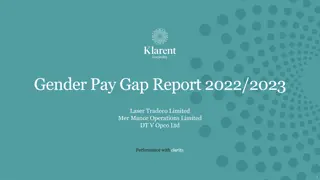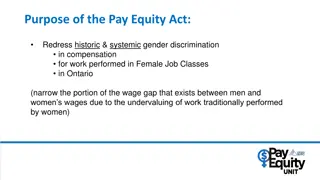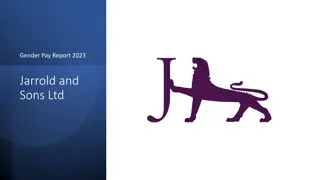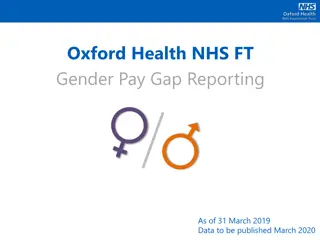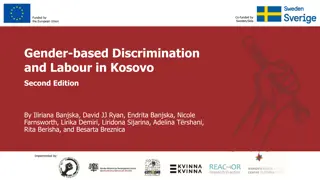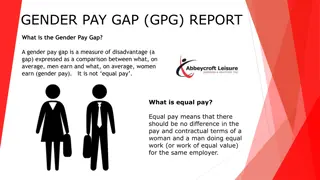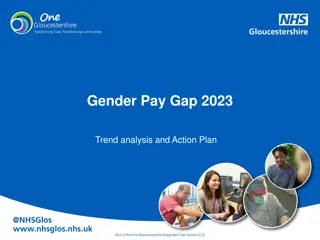Response to Pay Discrimination: Mr. Maqavana's Legal Battle
The Portfolio Committee on Employment & Labour evaluates Mr. Maqavana's pay discrimination case involving a white female colleague earning more. Despite legal frameworks, the case faces challenges, including a defense based on historical pay differences and dismissals by the CCMA and Labour Court due to res judicata. Maqavana seeks justice for alleged unfair discrimination based on various grounds, emphasizing the fight against inequality in remuneration practices.
Download Presentation

Please find below an Image/Link to download the presentation.
The content on the website is provided AS IS for your information and personal use only. It may not be sold, licensed, or shared on other websites without obtaining consent from the author.If you encounter any issues during the download, it is possible that the publisher has removed the file from their server.
You are allowed to download the files provided on this website for personal or commercial use, subject to the condition that they are used lawfully. All files are the property of their respective owners.
The content on the website is provided AS IS for your information and personal use only. It may not be sold, licensed, or shared on other websites without obtaining consent from the author.
E N D
Presentation Transcript
The Portfolio Committee on Employment & Labour DEL s response to proposed introduction of Fair Remuneration Draft Bill Meeting: 9 November 2022 1
Table of content DEL s response to the Pay discrimination experience & proposals of the complainant/ petitioner (Mr Phathuxolo Maqavana) Legal framework on Equal Pay: International obligations SA Constitutional guarantees EEAA, 2013 EE Regulations, 2014 Code of Good Practice on Equal Pay, 2015 2
DELs responses to Mr Maqavanas Pay discrimination experiences (CCMA Arbitration case) DEL s response In 2016, I learned that a white female with the same job title was earning significantly more than me. I was consistently told that the differentiation was based on my comparator having better experience, tenure, and qualifications a defence that was maintained throughout the pre-arbitration phase. Yes, in November 2016, Mr Maqavana referred a dispute of unfair discrimination to the CCMA in which he alleged that he did not receive equal pay for work of equal value when compared with colleagues or former colleagues, in particular, a white female, Ms Melles, who was also a merchandise Controller (Case no. GAJB24760-16 MAQAVANA/MASSBUILD). However, at arbitration a new defence was raised, namely that my comparator s pay was higher than mine because of differences in our historical pay. Without much regard to objective job related criteria, the company had used our past payslips (from previous careers) to determine our current pay. Arbitration award was issued on 31 August 2017 dismissing the case on the basis that: There was no evidence whatsoever of race playing a role (e.g. there were other merchandiser controllers that were black males, one black male that earned more than Mr Maqavana and one black male that earned less than him) Respondent/ Massbuild has shown on balance of probabilities that no discrimination took place. Massbuild has shown a rational, legitimate, fair and/ or genuine reason for the disparity, which is not discriminatory. 3
DELs responses to Mr Maqavanas Pay discrimination experiences (2nd dispute referral with CCMA & Review to the Labour Court) Mr Maqavana s Pay discrimination experience DEL s response 2nd dispute referral to CCMA: 2nd dispute referral to CCMA: On 20 November 2017 Mr Maqavana made another referral of dispute to the CCMA for unfair discrimination in pay based on an arbitrary ground (Case no. GAJB25304-17 MAQAVANA/ MASSBUILD). Upon receipt of referral - Massbuild raised a jurisdictional point of res judicata, which was enrolled for argument by CCMA on 10 January 2018. On 18 January 2018 - CCMA declined jurisdiction due to the fact the CCMA does not have jurisdiction to entertain the applicant s dispute as the same dispute was arbitrated and the matter is accordingly res judicata. Labour Court (LC) review process of CCMA award on res judicata: On 6 March 2018, Maqavana lunched the review application with the LC mainly on the basis that: Labour Court (LC) review process of CCMA award on res judicata: LC ruled on 3 April 2019 that the application for review was dismissed on the basis that: CCMA misconstrued the nature and cause of action of the first dispute on equal pay for work of equal value based on race; misconstrued the nature and cause of action of the present dispute; applied incorrect test for res judicata; etc. o A legal right that Maqavana has is that of not being unfairly discriminated against. Listed grounds such as race or any arbitrary ground are enablers of unfairness and not a separate and distinct cause of action, as such the 2nd dispute is the same as the 1st one; and o the ruling that the CCMA lacked jurisdiction is correct and is being upheld by this Court. Mr Maqavana alleges in his papers to this Committee that: This culminated in unsuccessful litigation up to and including the Constitutional Court of South Africa. No Labour Appeal Court or the Constitutional Court judgements on this matter were found. 4
DELs responses to Mr Maqavanas proposals to dismantling Pay discrimination Mr Maqavana s proposals to dismantling Pay discrimination DEL s response Informed by my own experience of this unfair pay practice; I have decided to launch a bill requesting Parliament to enact a law prohibiting the employment practice and level the paying field trough the promotion of pay transparency, and objective job evaluation. It is important to highlight that the EEA as amended in 2013, includes specific provisions on the elimination of unfair discriminatory employment policies and practices in terms and conditions of employment, including pay (sections 6(4) and 6(5) read with EE Regulations, 2014 (i.e. regulations 3 to 7). The employment practice of requesting past pay slips prior to making an offer of employment perpetuates the race and gender pay gap. Past pay slips have become the new dompas and are used by unscrupulous employers to exploit or low-ball black people and black women who continue to be affected by the legacy of apartheid In addition, Code of Good Practice on Equal Pay/ Remuneration for work of equal value, June 2015 which provide practical guidelines and best practice to employers and employees on how to implement the principle of equal pay, encourage employers to utilize a job evaluation and/ or grading system that is fair and transparent and does not have the effect of discriminating unfairly on any listed or arbitrary ground (i.e. paragraph 8.1.4 of the Code). To address this systemic inequality perpetuated by this employment practice, jurisdictions in the United States have passed salary history bans prohibiting employers from making enquiries into applicants salary history during the hiring process and further require that salaries be published in job ads. Section 5 of the EEA is also explicit that employers have a legal obligation to take steps to promote equal opportunities by eliminating unfair discrimination in their workplace. This includes ensuring that pay/ remuneration policies and practices are applied consistently without unfair discrimination on the basis of any one or a combination of the listed or on any other arbitrary grounds. It is my prayerful that Parliament of South Africa may equally pass such a prohibition and promotion of pay transparency. This would be key to dismantling systemic pay discrimination. In light of the above, if employers are using past salary slips/ salary history to perpetuate unfair pay discrimination contradictory to the existing equal pay laws the legal recourse provided must be followed to address non- compliance. 5
Legal framework on Equal Pay International obligations (ILO Convention 100) SA ratified the ILO Convention 100 (Equal Remuneration Convention, 1951) in 2000. Ratifying member states have a legal obligation to give effect to the principle of equal pay for work of equal value in their national laws. ILO Committee of Experts expressed dissatisfaction that the SA laws did not adequately cover equal pay principle. In order to comply with the international obligation, SA reviewed and amended the EEA in 2013 to include specific provisions on equal pay. 6
s9 of the Constitution Equality clause s 9(3) of the Constitution states that: the sate may not unfairly discriminate directly or indirectly against anyone on one or more grounds, including race, gender, sex, pregnancy, marital status, ethnic or social origin, colour, sexual orientation, age, disability, religion, conscience, belief, culture, language and birth. s 9(4) of the Constitution states that: no person may unfairly discriminate directly or indirectly against anyone on one or more grounds in terms of subsection (3). National legislation must be enacted to prevent or prohibit unfair discrimination. The obligation to eliminate unfair discrimination in respect of pay/ remuneration arises under Chapter II of the EEA S5 of the EEA requires employers to take positive steps to eliminate unfair discrimination in their employment policies and practices in the workplace. 7
EEAA, 2013 ss 6(1), 6(4) & 6(5) s 6(1) No person may unfairly discriminate, directly or indirectly, against an employee in any employment policy or practice, on one or more grounds including race, gender, sex, pregnancy, marital status, family responsibility, ethnic or social origin, colour, sexual orientation, age, disability, religion, HIV status, conscience, belief, political opinion, culture, language, birth or on any other arbitrary ground. s 6(4) A difference in terms and conditions of employment between employees of the same employer performing the same or substantially the same work or work of equal value that is directly or indirectly based on any one or more of the grounds listed in subsection (1) or on any other arbitrary ground, is unfair discrimination. s 6(5) The Minister, after consultation with the Commission, may prescribe the criteria and the methodology for assessing work of equal value. 8
EE Regulation 3 (Eliminating unfair discrimination) An employer must, in order to eliminate unfair discrimination, take steps to eliminate differences in terms and conditions of employment, including remuneration of employees who perform work of equal value if those differences are directly or indirectly based on a listed ground or any arbitrary ground that is prohibited by section 6(1) of the Act. An employer must ensure that employees are not paid different remuneration for work of equal value based on race, gender or disability. 9
EE Regulation 4 (Meaning of work of equal value) For the purpose of these Regulations, the work performed by an employee is the same as the work of another employee of the same employer, if their work is identical or interchangeable; is substantially the same as the work of another employee employed by that employer, if the work performed by the employees is sufficiently similar that they can reasonably be considered to be performing the same job, even if their work is not identical or interchangeable; is of the same value as the work of another employee of the same employer in a different job, if their respective occupations are accorded the same value in accordance with regulations 5 to 7. 10
EE Regulation 5 (Methodology) When, applying section 6(4) of the Act It must first be established- whether the work concerned is of equal value in accordance with regulation 6; and whether there is a difference in terms and conditions of employment, including remuneration. It must then be established whether any difference in terms of sub- regulation (1)(b) constitutes unfair discrimination, applying the provisions of section 11 of the EE Amendment Act. 11
EE Regulation 6 (Assessing whether work is of equal value) In considering whether work is of equal value, the following criteria must be taken into account: the responsibility demanded of the work, including responsibility for people, finances and material; the skills, qualifications, including prior learning and experience required to perform the work, whether formal or informal; physical, mental and emotional effort required to perform the work; and to the extent that it is relevant, the conditions under which work is performed, including physical environment, psychological conditions, time when and geographic location where the work is performed. 12
EE Regulation 6 (Assessing whether work is of equal value) Cont In addition to the criteria specified in sub-regulation (1), any other factor indicating the value of the work may be taken into account in evaluating work, provided the employer shows that the factor is relevant to assessing the value of the work. The assessment undertaken in terms of sub-regulation (1) and (2) must be conducted in a manner that is free from bias on grounds of race, gender or disability, any other listed ground or any arbitrary ground that is prohibited in terms of section 6(1) of the Act. Despite sub-regulation (1) and (2), an employer may justify the value assigned to an employee s work by reference to the classification of a relevant job in terms of a sectoral determination made by the Minister of Employment & Labour in terms of s55 of the BCEA, which applies to the employer. 13
EE Regulation 7 (Factors justifying differentiation in terms and conditions of employment) If employees perform work that is of equal value, a difference in terms and conditions of employment, including remuneration, is not unfair discrimination, if the difference is fair and rational, and is based on any one or a combination of the following grounds: the individuals respective seniority or length of service; the individuals respective qualifications, ability, competence or potential above the minimum acceptable levels required for the performance of the job; the individuals respective performance, quantity or quality of work, provided that employees are equally subject to the employer s performance evaluation system, that the performance evaluation system is consistently applied; 14
EE Regulation 7 (Cont) where an employee is demoted as a result of organisational restructuring or for any other legitimate reason without a reduction in pay and fixing the employee s salary at this level until the remuneration of employees in the same job category reaches this level; where an individual is employed temporarily in a position for purposes of gaining experience or training and as a result receives different remuneration or enjoys different terms and conditions of employment; the existence of a shortage of relevant skill, or the market value in a particular job classification; and any other relevant factor that is not unfairly discriminatory in terms of section 6(1) of the Act. 15
Code of Good Practice on Equal Pay (June 2015) Objectives of this Code: Provide practical guidance to employers and employees on how to implement the Equal Pay/ Remuneration for Work of Equal Value principle; Promote the implementation of the pay equity principle in the workplace through human resource policies and practices, and job evaluation processes; and Encourages employers to manage their pay equity policies and practices, and the consultation processes within a sound governance framework that will ensure the implementation of pay equity is fair, free from unfair discrimination and is consistently applied. 16
Comparing and evaluating male and female-dominated jobs Discrimination in pay/ remuneration based on the sex of employees is an international phenomenon found to a greater or lesser degree in all countries. The ILO has suggested these are mainly due to: stereotypeswith regard to women s work, e.g. nursing, social work, etc.; traditional job evaluation methods that were designed on the basis of male dominated jobs, e.g. mechanics, construction; and weaker bargaining power on behalf of female workers, e.g. domestic worker sector. The use of job evaluation does, in itself, not ensure that there is an absence of unfair discrimination. Employers are required to establish the value of male-and-female dominated jobs to ascertain if particular jobs have been under-valued and align female dominated jobs with comparable male- dominated jobs in the organisation. 17
Factors justifying differentiation in pay/ remuneration Once jobs have been evaluated and/ or graded, employers must ensure that pay/remuneration packages are allocated in accordance with the pay/ remuneration philosophy of the employer and is free from unfair discrimination. If employees perform work that is of equal value, a difference in terms and conditions of employment, including remuneration, is not unfair discrimination if the difference is fair and rational and is based on, amongst others, any one or a combination of justifiable factors such as seniority/ length of service, qualifications, performance, etc. 18
Job evaluation process to ensure equal pay/remuneration for work of equal value The following process may be used to determine equal pay/ remuneration for work of equal value Determine the scope of audit to be conducted to identify inequalities in pay/ remuneration on account of gender, race, disability or any other listed ground or on any other arbitrary ground; identify jobs that would be subjected to the audits; ensure that job profiles or job descriptions exist and are current before evaluating jobs; utilize a job evaluation and/ or grading system that is fair and transparent and does not have the effect of discriminating unfairly on any listed or arbitrary ground; compare jobs that are the same, similar or of equal value in the employer s own organization or company, including comparing female dominated jobs with male- dominated jobs as well as other that may have been under-valued. 19
Job evaluation process to ensure equal pay/remuneration for work of equal value (Cont ) select a method of comparing pay/remuneration, both in money and kind, in the relevant jobs by using either the average or the median earning of employees in the relevant jobs or any other method as long as it is fair and rational; identify the reasons for differentiating in pay/remuneration as contemplated by Regulation 7 in the Employment Equity regulations and determine whether they are justifiable; where differentiation is found not to be justifiable, determine how to address inequalities identified, without reducing the pay/ remuneration of employees to bring about equal remuneration; and monitor and review the process annually. 20
Questions Questions Who are the beneficiaries of this proposed Bill? What are the unintended consequences to those beneficiaries of this Bill? Is it enforceable? 21
Thank You Baie dankie Ke ea leboha 22




